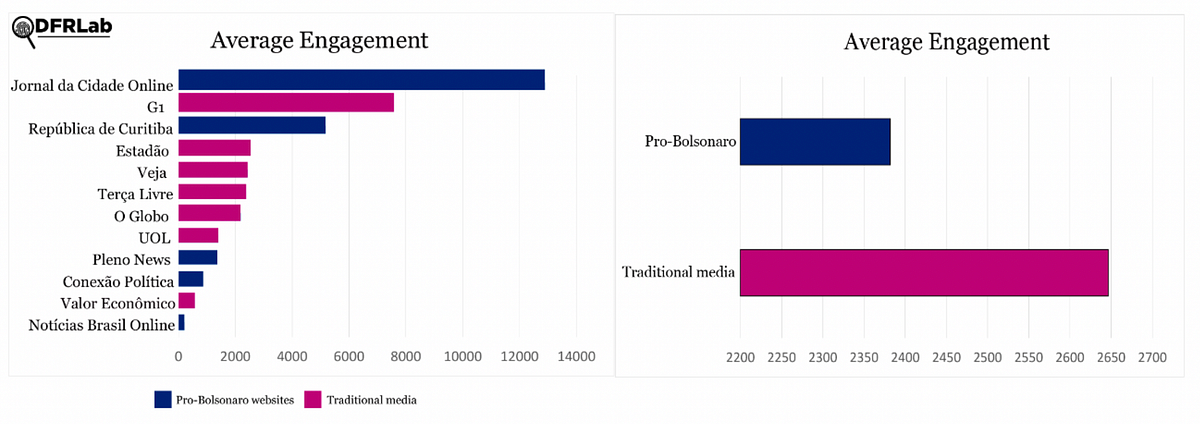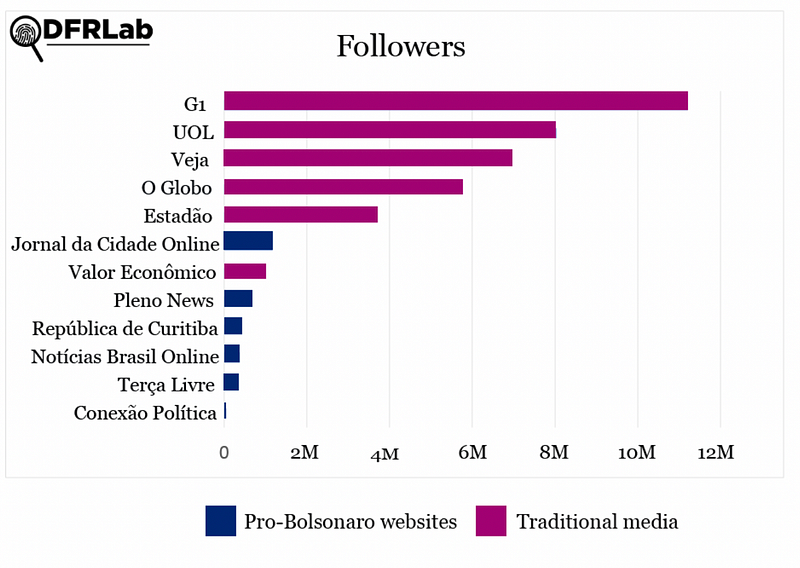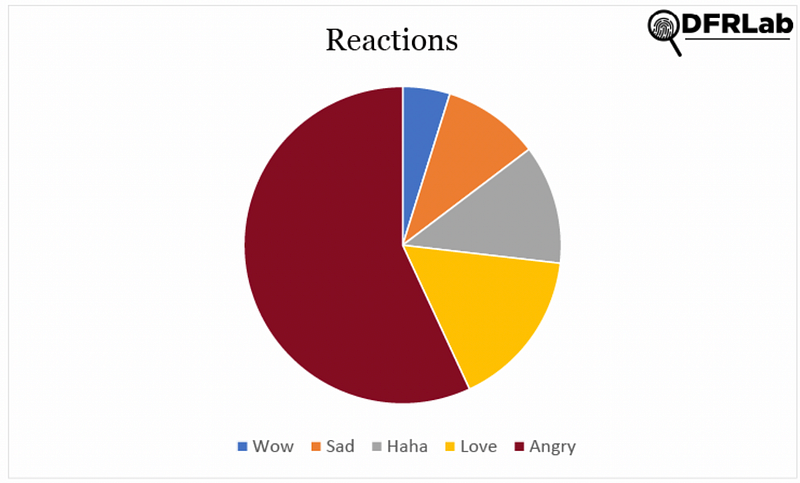Pro-Bolsonaro website receives more Facebook engagement than traditional media on COVID-19 coverage
Jornal da Cidade Online posts attacks
Pro-Bolsonaro website receives more Facebook engagement than traditional media on COVID-19 coverage

Jornal da Cidade Online posts attacks on critics of Bolsonaro and officials that support social distancing

Facebook posts about COVID-19 published by the pro-Bolsonaro website Jornal da Cidade Online significantly outperformed posts by traditional Brazilian media outlets about the same topic. While COVID-19 related posts from Jornal da Cidade Online received on average 12,000 interactions each, G1, the best performing established media outlet in Brazil, had an average of 7,500 interactions per post.
Jornal de Cidade Online managed to surpass G1 in terms of engagement even though the latter has 11 million followers, more than 11 times the number of followers Jornal de Cidade Online has. Among the most interacted with content published by Jornal da Cidade Online were posts politicizing the COVID-19 crisis, including articles attacking officials that were supporting strict social distancing measures, such as the former Health Minister Luiz Henrique Mandetta. President Jair Bolsonaro has downplayed the pandemic and claimed the country must reopen for economic reasons.
Attacking those that go against Bolsonaro is a common strategy adopted by the pro-Bolsonaro disinformation architecture that has emerged in Brazil. This data suggests that, on Facebook, Jornal da Cidade Online is the most successful right-wing website participating in this architecture.
Fact-checking websites in Brazil have previously flagged the website as a source of disinformation. In addition, as revealed by the fact-checking website Aos Fatos, Jornal da Cidade Online uses fake personas as authors, and its monetization strategy is connected to the website Verdade Sufocada, which is run by the widow of Carlos Alberto Brilhante Ustra, who served as a torturer under the military dictatorship that ruled Brazil from 1965 to 1985.
Online engagement
The DFRLab used the social listening tool CrowdTangle to compare engagement (comments, shares, likes, and other reactions) with COVID-19 related posts from legacy media and fringe pro-Bolsonaro websites dating back to January 1, 2020.
Overall, posts by traditional media received more engagement than those by fringe media. This may be due to the fact that traditional media posted more stories about COVID-19 than the fringe media. The average engagement per post is similar: traditional media had on average 2,647 engagements, while fringe media had 2,382.

When the data was broken down by outlet, Jornal da Cidade Online emerged as the primary outlier in terms of average engagement. República de Curitiba also received significant engagement, outperforming most legacy outlets. In 2018, República de Curitiba’s Facebook page was removed from the platform for coordinated inauthentic behavior. At the time, the website was enjoying a high rate of engagement, constituting the second-most engaged with outlet in Brazil when publishing election-related articles.
Fringe outlets were able to achieve similar engagement rates to legacy media outlets despite having fewer followers. This finding suggests that accounts following fringe websites were more active in sharing, commenting, and liking posts than those that follow legacy media.

Jornal da Cidade Online
Jornal da Cidade Online has a history of promoting inaccurate information and using the names of fictitious personas and stolen pictures in article bylines. Despite ample coverage of its questionable reporting practices, the website has managed to amass more engagement than trustworthy outlets, such as G1, which is linked to Grupo Globo, the primary media conglomerate in the country. Jornal da Cidade Online outperforms G1’s engagement not only on COVID-19 related stories, but also on stories related to other topics.

The website’s COVID-19 coverage is similar to that of other pro-Bolsonaro outlets, following the same narrative pushed by President Bolsonaro, who has claimed that the novel coronavirus is not as serious a threat as it is made out to be, and that the economic consequences of imposing strict social distancing measures in an attempt to halt the virus will do more damage than the virus itself.
Bolsonaro’s supporters and pro-Bolsonaro websites also routinely attack those that contradict the president. The five most engaged with stories published by Jornal da Cidade Online mentioning COVID-19 all attacked Bolsonaro’s rivals or the press. Among those targeted were historical rivals, such as the former president, Luiz Inácio Lula da Silva, and recurring “enemies,” such as Luiz Henrique Mandetta, Brazil’s former Health Minister who was fired in part for advocating for social distancing measures. The press was also criticized for its allegedly unfair coverage of the president.

The aggressive tone is also reflected in the most common reactions to the posts. Disregarding likes, which are the most common reaction on Facebook as a whole, accounts that interacted with Jornal da Cidade Online use the “angry” reaction more often than they use the others, such as “love,” “sad,” “wow,” and “haha.”

The “angry” reactions can be linked with the websites’ headlines, which are written in a way that elicits emotional responses. It would be possible to argue that angry reactions are a sign that people disagreed and were angry with the website, rather than with the facts described in the post. However, comments in the posts imply that users engaging with posts agree with the website’s take on facts and are angry with what the stories describe.
The fact that this website is receiving so much attention when it posts about COVID-19 does not necessarily mean that the users who are reacting will act upon it. However, in the context of a public health crisis, when providing timely, objective reporting to the public is an imperative, the finding that Jornal da Cidade Online is receiving outstanding engagement is concerning.
Luiza Bandeira is a Research Associate, Latin America, with the Digital Forensic Research Lab.
Follow along on Twitter for more in-depth analysis from our #DigitalSherlocks.

